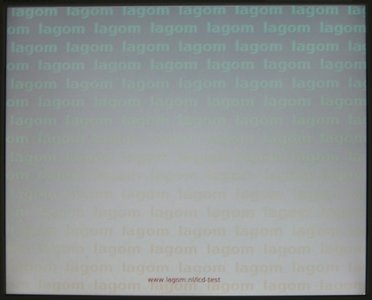LCD monitors are usually advertised as having a viewing angle of somewhere between 140 and 165 degrees. This means that you can still see what's on the display if you are looking at it at 70 to 83 degrees from the side. However, most of the time, you will be sitting roughly straight in front of the screen, which means that you are looking at 0 degrees to the center of the screen and at most 45 degrees to the sides. Compared to the advertised viewing angle, it is much more relevant that the display does not change brightness or color in the corners. The following test images are best viewed from a distance of approximately equal to the diagonal of the display.
The word 'lagom' on this image should blend in with the background everywhere; otherwise the gamma curve of your monitor is dependent on the viewing angle, which is the case with most displays based on TN technology. Typically, the letters appear blue-green at the top and red at the bottom. Note: this test image requires that the screen operates in its native resolution and that the image is not scaled.
Each of the following images contains only a single color that fills the whole plane. When your eyes are close to the screen, the color in the middle and close to the edges should look the same.
This first one, in purple, is the most revealing one on my display. The color appears to vary between lavender and pale blue.
The red surface may appear to vary between deep red and purplish-pinkish red
The green image may appear to vary between pure green and yellowish green.
This surface is pure blue and will probably only show brightness differences, rather than color differences.
This is what the Gamma viewing angle test looks like on a fairly typical mid-range LCD monitor (a 2005 model) based on a TN matrix.
The first photo is taken from a distance equal to the screen diagonal. Yes, that's fairly horrible, but unfortunately rather common.


The second photo is the same monitor, but taken from twice the screen diagonal. Slightly better, but imagine that you are trying to adjust the color balance of a photo on a screen like that...
Unfortunately, you can't change anything about the angle dependence of a monitor, except by replacing it by a better monitor. Some newer TN-based monitors are a bit better than the sample above, but a monitor with a MVA/PVA or IPS matrix can perform vastly better than this.

When looked at from a close distance (i.e. at a distance roughly equal to the monitor diagonal size), the purple surface might look like this. The color changes vertically from pinkish to blue and is darker in the edges compared to the center. This is a typical behavior of TN (twisted nematic) LCD screens.
© Copyright Han-Kwang Nienhuys, 2008. The text and accompanying images may not be redistributed. This includes placing the images on other websites, either as a copy or through hotlinking. Read more...